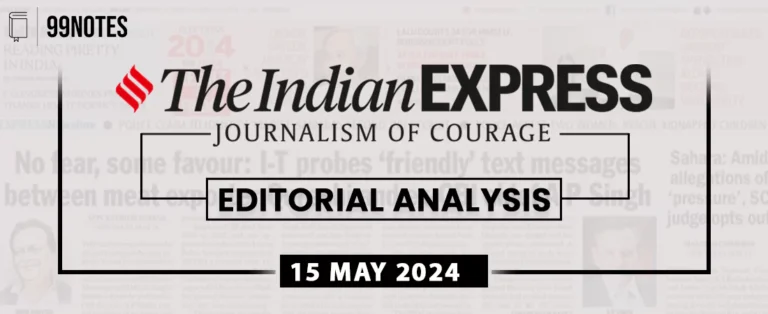19 Feb 2024 : Indian Express Editorial Analysis
Indian Express Editorial Analysis
19-February-2024
1. Income, not MSP
| Topic: GS3 – Agriculture – MSP This topic is relevant for both Prelims and Mains in the context of knowing facts about economic policies surrounding agriculture, including MSPs, subsidies, and market dynamics. |
| Context: |
|
Key Demands of Farmers:
- The farmers are advocating for significant reforms in agricultural policies, including making minimum support prices (MSPs) legally binding and adjusting them according to the Swaminathan formula, which suggests a 50 percent profit margin over comprehensive costs, termed Cost C2.
- This cost framework comprises various elements, such as paid-out costs, imputed value of family labor, imputed rent on owned land, and imputed interest on owned capital.
- The implementation of this formula could lead to a substantial increase in MSPs, potentially by 25 to 30 percent across most crops.
Other Demands and Economic Implications:
- Additionally, farmers are demanding loan waivers, pensions, a minimum wage rate, and the inclusion of MGNREGA workers in agricultural activities.
- However, meeting these demands could have significant economic repercussions, including fiscal strain and heightened food inflation.
- Hence, any decision on these demands must be approached with a rational mindset, devoid of emotional or political influences, especially during the election period.
Understanding Farmers’ Core Issue:
- Beneath these economic demands lies the fundamental aspiration of farmers for higher incomes, which is a reasonable desire shared by many.
- However, the government must carefully assess its ability to meet these demands without destabilizing the economy.
- The fiscal implications of such a package are complex and dependent on various factors, including the number of commodities covered, market prices, and the extent of loan waivers and pensions.
Expanding MSP Reforms and Market Dynamics:
- Expanding MSP reforms beyond the current 23 crops to include other agricultural products like milk, livestock, and horticulture is crucial.
- These sectors contribute significantly to agricultural production and have experienced robust growth, often without MSP support.
- A well-integrated value chain approach, akin to successful models such as Amul in milk production, is necessary to ensure sustainable growth and fair compensation for producers.
Enhancing Farmer Incomes:
- Augmenting productivity through investments in agricultural research and development and irrigation infrastructure is essential for long-term income growth.
- Simultaneously, improving access to domestic and international markets can provide immediate benefits.
- Removing restrictions on agricultural exports and stocking limits, as well as ensuring fair pricing mechanisms, are imperative steps towards empowering farmers economically.
Reorienting Subsidy Policies:
- The current subsidy policies predominantly favor consumers over producers, exacerbating the imbalance in agricultural economics.
- A reevaluation of subsidy allocations, with a shift towards supporting producers through mechanisms like price stabilization funds or targeted assistance programs, is necessary.
- This realignment can create a more equitable agricultural sector while ensuring food security for vulnerable consumers.
Conclusion:
- Addressing the grievances of protesting farmers requires a balanced and pragmatic approach from policymakers.
- By prioritizing the economic well-being of farmers and implementing reforms that enhance productivity and market access, the government can alleviate their concerns while safeguarding the broader interests of the economy.
- It’s imperative for policymakers to demonstrate the will to enact meaningful change and navigate the complexities of agricultural policy with diligence and foresight.
| Why are Farmers Protesting Across the Globe? |
South America:
Europe:
North and Central America:
Asia:
Oceania:
|
| PYQ: Consider the following statements: (2023) 1) The Government of India provides Minimum Support Price for niger (Guizotia abyssinica) seeds. 2) Niger is cultivated as a Kharif crop. 3) Some tribal people in India use niger seed oil for cooking. How many of the above statements are correct? (a) Only one (b) Only two (c) All three (d) None Ans: (c) |
| Practice Question: What are the core demands of the protesting farmers, predominantly from Punjab, and what economic implications do these demands pose for the government? How can policymakers address the farmers’ aspirations for higher incomes while ensuring the sustainability of the agricultural sector and mitigating potential fiscal strains? (250 words/15 m) |
2. RIGHTS OF THE SINGLE WOMAN
| Topic: GS2 – Social Justice – Vulnerable sections – Mechanisms, laws, institutions and Bodies constituted for the protection and betterment of these vulnerable sections. This topic is relevant for both Prelims and Mains in the context of discrimination against single women in accessing surrogacy services which raises constitutional questions related to equality, non-discrimination, and social justice. |
| Context: |
|
Legal Challenges and Societal Attitudes:
- The Surrogacy (Regulation) Act 2021 permits only married couples or single women between the ages of 35 to 45, who are widowed or divorced, to undergo surrogacy.
- However, it excludes single, never-married women from this option.
- The recent petition challenging this provision highlights the discriminatory nature of the law, particularly against single women, who are seen as stigmatized and marginalized in society’s reproductive choices.
Sex-Based Inequality and Stereotypes:
- Single, never-married women in India often face negative stereotypes and social stigma, with their desire for biological children being viewed as wanting to “have it all.”
- This discrimination is deeply rooted in societal perceptions, where married individuals are favored over single women.
- The Surrogacy (Regulation) Act perpetuates these biases by granting preferential treatment to married individuals, further marginalizing single women.
Systemic Disadvantages and Legal Barriers:
- The discrimination against single women extends beyond surrogacy laws to other reproductive rights issues.
- The Medical Termination of Pregnancy Act, for instance, does not address the single status of women seeking abortions, leading to significant barriers in accessing safe abortion services.
- Despite positive interpretations by the Supreme Court, single women still encounter obstacles in exercising their reproductive rights.
Need for Legal Reform and Equality:
- The restrictive laws and societal attitudes surrounding surrogacy and reproductive rights underscore the urgent need for legal reform to ensure equality for single women.
- The increasing number of single women in India highlights the significance of addressing these issues to enhance their reproductive rights and access to surrogacy and fertility treatments.
Challenges in Traditional Notions of Parenthood:
- Traditional notions of parenthood, including the emphasis on the need for fathers, perpetuate discrimination against single women and queer couples.
- Advocates argue for a shift towards recognizing supported parenting rather than rigid gender roles, aligning with the evolving understanding of family structures and the welfare of children.
Conclusion:
- The rising population of single women in India demands a reevaluation of surrogacy laws and broader reproductive rights policies to ensure equality and recognition for all individuals.
- Legal reforms must address systemic discrimination and societal biases to empower single women in making informed decisions about their reproductive choices in contemporary India.
| What are the Recent Changes Made by the Supreme Court? |
|
| PYQ: In the context of recent advances in human reproductive technology, “Pronuclear Transfer” is used for (2020) (a) fertilization of egg in vitro by the donor sperm (b) genetic modification of sperm producing cells (c) development of stem cells into functional embryos (d) prevention of mitochondrial diseases in offspring Ans: (d) |
| Practice Question: Critically examine the provisions of the Surrogacy (Regulation) Act 2021 in India with respect to its impact on single women’s reproductive rights. Evaluate the legal and societal implications of the Act’s restrictions on surrogacy access for single women and propose measures for legislative reform to promote equality in reproductive healthcare. (250 words/15 m) |
For Enquiry

19 Feb 2024 : Indian Express Editorial Analysis

17 Feb 2024 : Daily Current Affairs Quiz

17 Feb 2024 : Daily Answer Writing

17 Feb 2024 : Daily Current Affairs

17 February 2024 : The Hindu Editorial Notes PDF

17 Feb 2024 : Indian Express Editorial Analysis

17 February 2024 : PIB Summary for UPSC

16 Feb 2024 : Daily Current Affairs Quiz

16 Feb 2024 : Daily Answer Writing

16 Feb 2024 : Daily Current Affairs
Indian Express 19 Feb 2024 : Indian Express Editorial Analysis Indian Express Editorial Analysis
19-February-2024
1. Income, not MSP
Topic: GS3 – Agriculture –…
Daily Quiz 17 Feb 2024 : Daily Current Affairs Quiz 17 Feb 2024 : Daily Quiz…
mains answer writing 17 Feb 2024 : Daily Answer Writing Mains Answer Writing
17-February-2024
Q1) “The Indian Independence Act 1947 changed the existing constitutional…
Daily Current Affairs 17 Feb 2024 : Daily Current Affairs Daily Current Affairs
17-February-2024- Top News of the Day
1. ED probe finds no FEMA violations in…
Feb 2024 The Hindu 17 February 2024 : The Hindu Editorial Notes PDF The Hindu Editorial
17-February-2024
1. The clear message in the Court’s ‘no’ to electoral bonds.
Topic:…
Indian Express 17 Feb 2024 : Indian Express Editorial Analysis Indian Express Editorial Analysis
17-February-2024
1. The MSP fallacy
Topic: GS3 – Agriculture –…
feb 2024 PIB 17 February 2024 : PIB Summary for UPSC PIB Summary for UPSC
17-February -2024
1. Central Consumer Protection Authority (CCPA) seeks public…
Daily Quiz 16 Feb 2024 : Daily Current Affairs Quiz 16 Feb 2024 : Daily Quiz…
mains answer writing 16 Feb 2024 : Daily Answer Writing Mains Answer Writing
16-February-2024
Q1) What is the process for amending the Constitution of India?…
Daily Current Affairs 16 Feb 2024 : Daily Current Affairs Daily Current Affairs
16-February-2024- Top News of the Day
1. Supreme Court Strikes Down Amendments…





